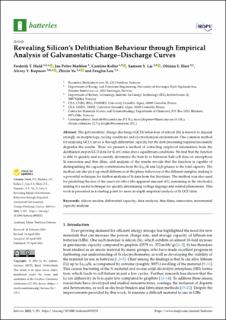| dc.contributor.author | Huld, Frederik Thorbjørn | |
| dc.contributor.author | Mæhlen, Jan Petter | |
| dc.contributor.author | Keller, Caroline | |
| dc.contributor.author | Lai, Samson Yuxiu | |
| dc.contributor.author | Eleri, Obinna Egwu | |
| dc.contributor.author | Koposov, Alexey | |
| dc.contributor.author | Yu, Zhixin | |
| dc.contributor.author | Lou, FengLiu | |
| dc.date.accessioned | 2023-10-25T07:46:39Z | |
| dc.date.available | 2023-10-25T07:46:39Z | |
| dc.date.created | 2023-06-09T10:05:15Z | |
| dc.date.issued | 2023-04 | |
| dc.identifier.citation | Huld, F. T., Mæhlen, J. P., Keller, C., Lai, S. Y., Eleri, O. E., Koposov, A. Y., Yu, Z., & Lou, F. (2023). Revealing Silicon’s Delithiation Behaviour through Empirical Analysis of Galvanostatic Charge–Discharge Curves. Batteries, 9(5), 251. | en_US |
| dc.identifier.issn | 2313-0105 | |
| dc.identifier.uri | https://hdl.handle.net/11250/3098572 | |
| dc.description.abstract | The galvanostatic charge–discharge (GCD) behaviour of silicon (Si) is known to depend strongly on morphology, cycling conditions and electrochemical environment. One common method for analysing GCD curves is through differential capacity, but the data processing required necessarily degrades the results. Here we present a method of extracting empirical information from the delithiation step in GCD data for Si at C-rates above equilibrium conditions. We find that the function is able to quickly and accurately determine the best fit to historical half-cell data on amorphous Si nanowires and thin films, and analysis of the results reveals that the function is capable of distinguishing the capacity contributions from the Li3.5 Si and Li2 Si phases to the total capacity. The method can also pick up small differences in the phase behaviour of the different samples, making it a powerful technique for further analysis of Si data from the literature. The method was also used for predicting the size of the reservoir effect (the apparent amount of Li remaining in the electrode), making it a useful technique for quickly determining voltage slippage and related phenomena. This work is presented as a starting point for more in-depth empirical analysis of Si GCD data. | en_US |
| dc.language.iso | eng | en_US |
| dc.publisher | MDPI | en_US |
| dc.rights | Navngivelse 4.0 Internasjonal | * |
| dc.rights.uri | http://creativecommons.org/licenses/by/4.0/deed.no | * |
| dc.title | Revealing Silicon’s Delithiation Behaviour through Empirical Analysis of Galvanostatic Charge–Discharge Curves | en_US |
| dc.type | Peer reviewed | en_US |
| dc.type | Journal article | en_US |
| dc.description.version | publishedVersion | en_US |
| dc.rights.holder | © 2023 by the authors | en_US |
| dc.subject.nsi | VDP::Teknologi: 500 | en_US |
| dc.source.pagenumber | 13 | en_US |
| dc.source.volume | 9 | en_US |
| dc.source.journal | Batteries | en_US |
| dc.source.issue | 5 | en_US |
| dc.identifier.doi | 10.3390/batteries9050251 | |
| dc.identifier.cristin | 2153244 | |
| dc.relation.project | Norges forskningsråd: 280985 | en_US |
| dc.relation.project | Norges forskningsråd: 257653 | en_US |
| cristin.ispublished | true | |
| cristin.fulltext | original | |
| cristin.fulltext | original | |
| cristin.qualitycode | 1 | |

